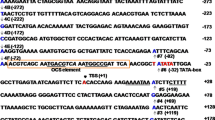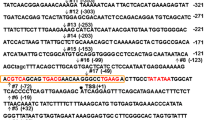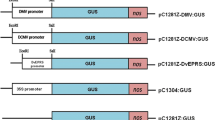Abstract
A segment of DNA from the genome of figwort mosaic virus (FMV) strain M3 possesses promoter activity when tested in electroporated protoplasts from, and transgenic plants of, Nicotiana tabacum cv. Xanthi nc. The 1.1 kb DNA segment, designated the ‘34S’ promoter, is derived from a position on the FMV genome comparable to the position on the cauliflower mosaic virus (CaMV) genome containing the 35S promoter. The 34S and 35S promoters show approximately 63% nucleotide homology in the TATA, CCACT, and −18 to +1 domains, but in sequences further upstream the homology drops below 50%. Promoter activities were estimated using β-glucuronidase and neomycin phosphotransferase II reporter gene systems. The activity of the 34S promoter segment approximates that of the 35S promoter in both protoplast transient expression assays and in stably transformed tobacco plants. Truncation of 5′ sequences from the 34S promoter indicates that promoter strength depends upon DNA sequences located several hundred nucleotides upstream from the TATA box. In leaf tissue the 34S promoter is 20-fold more active than the mannopine synthase (MAS) promoter from Agrobacterium tumefaciens T-DNA. The 34S promoter lacks the root-specific and wound-stimulated expression of the MAS promoter, showing relatively uniform root, stem, leaf, and floral activities.
Similar content being viewed by others
References
An G: Development of plant promoter expression vectors and their use for analysis of differential activity of nopaline synthase promoter in transformed tobacco cells. Plant Physiol 81: 86–91 (1986).
Ausbel FM, Brent R, Kingston RE, Moore DD, Seidman JG, Smith JA, Struhl K (eds): Current Protocols in Molecular Biology. John Wiley and Sons, New York (1987).
Balazs E, Guilley H, Jonard G, Richards K: Nucleotide sequence of DNA from an altered-virulence isolate D/H of the cauliflower mosaic virus. Gene 19: 239–249 (1982).
Barker RF, Idler KB, Thompson DV, Demp JD: Nucleotide sequence of the T-DNA region from the Agrobacterium tumefaciens octopine Ti plasmid pTi 15955. Plant Mol Biol 2: 335–350 (1983).
Benfey PN, Ren L, Chua N-H: The CaMV 35S enhancer contains at least two domains which can confer different developmental and tissue-specific expression patterns. EMBO J 8: 2195–2202 (1989).
Bio-Rad: Automated protein assay. Bulletin 1177 (1984).
Bonneville J, Hohn T, Pfeiffer P: Reverse transcription in the plant virus, cauliflower mosaic virus. In: DomingoE, HollandJ, Ahlquist P (eds) RNA Genetics, vol 2, pp. 23–42. CRC Press, Boca Raton, FL (1988).
Bradford MM: A rapid and sensitive method for the quantitation of microgram quantities of protein utilizing the principle of protein-dye binding. Anal Biochem 72: 248–254 (1976).
Burzio LO, Brito M, Zarraga AM, Siddiqui MAQ: Assay of chloramphenicol acetyltransferase by high-performance liquid chromatography. Gene Anal Techn 5: 5–8 (1988).
Comai L, Facciotti D, Hiatt WR, Thompson G, Rose E, Stalker DM: Expression in plants of a mutant aroA gene from Salmonella typhimurium confers tolerance to glyphosate. Nature 317: 741–744 (1985).
Dean C, Favreau M, Tamaki S, Bond-Nutter D, Dunsmuir P, Bedbrook J: Expression of tandem gene fusions in transgenic tobacco plants. Nucl Acids Res 15: 7601–7617 (1988).
Fang R-X, Nagy F, Sivasubramaniam S, Chua N-H: Multiple cis regulatory elements for maximal expression of the cauliflower mosaic virus 35S promoter in transgenic plants. Plant Cell 1: 141–150 (1989).
Fang R, Wu X, Bu M, Tian Y, Cai F, Mang K: Complete nucleotide sequence of cauliflower mosaic virus (Xinjing isolate) genomic DNA. Chinese J Virol 1: 247–256 (1985).
Franck A, Guilley H, Jonard G, Richards K, Hirth L: Nucleotide sequence of cauliflower mosaic virus DNA. Cell 21: 285–294 (1980).
Fromm M, Taylor LP, Wolbot V: Expression of genes transferred into monocot and dicot plant cells by electroporation. Proc Natl Acad Sci USA 82: 5824–5828 (1985).
Fromm ME, Taylor LP, Wolbot V: Stable transformation of maize after gene transfer by electroporation. Nature 319: 791–793 (1986).
Gardner RC, Howarth AJ, Hahn P, Brown-Leudi M, Shepherd RJ: The complete nucleotide sequence of an infectious clone of cauliflower mosaic virus by M13mp7 shotgun sequencing. Nucl Acids Res 9: 2871–2881 (1981).
Gorman CM, Moffat LF, Howard BH: Recombinant genomes which express chloramphenicol acetyl transferase in mammalian cells. Mol Cel Biol 2: 1044–1051 (1982).
Guilley H, Dudley RK, Jonard G, Balàzs E, Richards KE: Transcription of cauliflower mosaic virus DNA: detection of promoter sequences, and characterization of transcripts. Cell 30: 763–773 (1982).
Hoekema A, Hirsch PR, Hooykaas PJ, Schilperoort RA: A binary plant vector strategy based on separation of vir-and T-region of the Agrobacterium tumefaciens Ti-plasmid. Nature 303: 179–180 (1983).
Hoekema A, Huisman MJ, Molendijk L, van den Elzen PJ, Cornelissen BJ: The genetic engineering of two commercial potato cultivars for resistance to potato virus X. Bio/Technology 7: 273–278 (1989).
Holstus MD, deWarle D, Depicker A, Messens E, VanMontagu M, Schell J: Transfection and transformation of Agrobacterium tumefaciens. Mol Gen Genet 163: 181–187 (1979).
Hull R, Sadler J, Longstaff M: The sequence of carnation etched ring viral. DNA: comparison with cauliflower mosaic virus and retroviruses. EMBO J 5: 3083–3090 (1986).
Jefferson RA: Assaying chimeric genes in plants: the GUS gene fusion system. Plant Mol Biol Rep 5(4): 387–405 (1987).
Jefferson RA, Kavanagh TA, Bevan MV: GUS fusions: β-glucuronidase as a sensitive and versatile gene fusion marker in higher plants. EMBO J 6: 3901–3907 (1987).
Jones JD, Gilbert DE, Grady KL, Jorgensen RA: T-DNA structure and gene expression in petunia plants transformed by Agrobacterium tumefaciens C58 derivatives. Mol Gen Genet 207: 478–485 (1987).
Langridge WHR, Fitzgerald KJ, Koncz C, Schell J, Szaly AA: Dual promoter of Agrobacterium tumefaciens mannopine synthase genes is regulated by plant growth hormones. Proc Natl Acad Sci USA 86: 3219–3232 (1989).
Lin W, Odell JT, Schreiner RM: Soybean protoplast culture and direct gene uptake and expression by cultured soybean protoplasts. Plant Physiol 84: 856–861 (1987).
Maniatis T, Fritsch EF, Sambrook J: Molecular Cloning: A Laboratory Manual. Cold Spring Harbor Laboratory, Cold Spring Harbor, NY (1982).
McDonnell RE, Clark RD, Smith WA, Hinchee MA: A simplified method for the detection of neomycin phosphotransferase II activity in transformed plant tissues. Plant Mol Biol Rep 5: 380–386 (1987).
Murashige T, Skoog F: A revised medium for rapid growth and bio-assay with tobacco tissue cultures. Physiol Plant 15: 473–497 (1962).
Nagy F, Odell JT, Morelli G, Chua N-H: Properties of expression of the 35S promoter from CaMV in transgenic tobacco plants. In: Zaitlin M, Day P, Hollaender A (eds) Biotechnology in Plant Science: Relevance to Agriculture in the Eighties, pp. 227–236. Academic Press, New York (1985).
Odell JT, Knowlton S, Lin W, Mauvais J: Properties of an isolated transcription stimulating sequence derived from the cauliflower mosaic virus 35S promoter. Plant Mol Biol 10: 263–272 (1988).
Odell JT, Nagy F, Chua N-H: Identification of sequences required for activity of the cauliflower mosaic virus 35S promoter. Nature 313: 810–812 (1985).
Odell JT, Nagy F, Chua N-H: Variability in 35S promoter expression between independent transformants. In: Key J, McIntosh L (eds), Plant Gene Systems and Their Biology, vol 62, pp. 321–329. Alan R. Liss, New York (1987).
Ou-Lee TM, Turgeon R, Wu R: Expression of a foreign gene linked to either a plant-virus or a Drosophila promoter, after electroporation of protoplasts of rice wheat, and sorghum. Proc Natl Acad Sci USA 83: 6815–6819 (1986).
Ow DW, Jacobs JD, Howell SH: Functional regions of the cauliflower mosaic virus 35S RNA promoter determined by use of the firefly luciferase gene as a reporter of promoter activity. Proc Natl Acad Sci USA 84: 4870–4874 (1987).
Ow DW, Wood KV, De Luca M, de Wet JR, Helinski DR, Howell SH: Transient and stable expression of the firefly luciferase gene in plant cells and transgenic plants. Science 234: 856–859 (1986).
Richins RD, Scholthof HB, Shepherd RJ: Sequence of figwort mosaic virus DNA (caulimovirus group). Nucl Acids Res 15: 8451–8466 (1987).
Sanders PR, Winters JA, Barnason AR, Rogers SG, Fraley RT: Comparison of cauliflower mosaic virus 35S and nopaline synthase promoters in transgenic plants. Nucl Acids Res 15: 1543–1558 (1987).
Sanger F, Nicklen S, Coulson AR: DNA sequencing with chain terminating inhibitors. Proc Natl Acad Sci USA 74: 5463–5467 (1974).
Shepherd RJ, Richins RD, Duffus JE, Handley MK: Figwort mosaic virus: properties of the virus and its adaption to a new host. Phytopathology 77: 1668–1673 (1987).
Stratfor dR, Plaskitt K, Turner D, Markham P, Covey S: Molecular properties of Bari 1, a mild strain of cauliflower mosaic virus. J Gen Virol 69: 2375–2386 (1988).
Teere TH, Lehväslaiho H, Franck M, Uotila J, Heino P, Palva ET, VanMontagu M, Herrera-Estrella L: Gene fusions to lacZ reveal new expression patterns of chimeric genes in transgenic plants. EMBO J 8: 343–350 (1989).
Winter JA, Wright RL, Gurley WB: Map locations of five transcripts homologous to TR-DNA in tobacco and sunflower crown gall tumors. Nucl Acids Res 12: 2391–2406 (1984).
Yanisch-Perron C, Vieira J, Messing J: Improved M13 phage cloning vectors and host strains: nucleotide sequences of the M13mp18 and pUC19 vectors. Gene 33: 103–119 (1985).
Author information
Authors and Affiliations
Rights and permissions
About this article
Cite this article
Sanger, M., Daubert, S. & Goodman, R.M. Characteristics of a strong promoter from figwort mosaic virus: comparison with the analogous 35S promoter from cauliflower mosaic virus and the regulated mannopine synthase promoter. Plant Mol Biol 14, 433–443 (1990). https://doi.org/10.1007/BF00028779
Received:
Accepted:
Issue Date:
DOI: https://doi.org/10.1007/BF00028779




